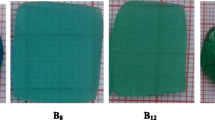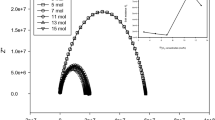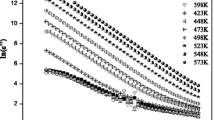Abstract
Glass systemxCuO-(100-x) Bi2O3 in the composition range 30–60 mol% of CuO is prepared by melt-quenching technique. The ESR spectra show no hyperfine splittings in parallel part but the peak to peak field width is found to vary with CuO content. The observedg effective values are found to vary with copper oxide. The absence of hyperfine splittings is due to inhomogeneous broadening. The observed IR spectra suggest the presence of Bi-O bonds. The structure is changing from [BiO6] octahedral to [BiO3] pyramidal units with increasing CuO concentration. D.C. electrical conductivity results indicate that the conduction is electron in nature and arises out of adiabatic hopping of polarons. The activation energy is found to be concentration and temperature dependent.
Similar content being viewed by others
References
Austin I G and Mott N F 1969Adv. Phys. 18 41
Bishay A and Maghrabi C 1969Phys. Chem. Glasses 10 1
Dumbaugh W H 1978Phys. Chem. Glasses 19 121
Dumbaugh W H 1986Phys. Chem. Glasses 27 119
Ghosh A and Chaudhuri B K 1986J. Non-Cryst. Solids 83 151
Ghosh A and Chakravorty D 1990J. Phys. Condens. Matter 2 931
Hazra S and Ghosh A 1995Phys. Rev. B51 851
Komatsu T, Sato R, Imai K, Matusita K and Yamashita T 1988Jpn J. Appl. Phys. 27 L550
Livage J, Pineau P, Leroy M C and Michand M 1977Phys. Status Solidi A39 73
Mandal S and Ghosh A 1993Phys. Rev. B48 9388
Minami T, Akamatsu Y, Tatsumisago M, Toghe N and Kowada Y 1988Jpn J. Appl. Phys. 27 L777
Mott N F 1968J. Non-Cryst. Solids 1 1
Murawski L, Chung C H and Meckenzie J D 1979J. Non-Cryst. Solids 32 91
Onisi M, Kyoto M and Watanabe M 1991Jpn J. Appl. Phys. 30 L988
Sayer M and Mansingh A 1972Phys. Rev. B6 4626
Tatsumisago M, Tsuboi S, Toghe N and Minami T 1990J. Non-Cryst. Solids 124 167
Yuan L R, Kurosawa K, Takigawa Y, Okuda M, Naito H, Nakahigashi K, Nakanishi S and Matsushita T 1991Jpn J. Appl. Phys. 30 L1545
Yawale S P and Pakade S V 1993J. Mater. Sci. 28 5451
Zheng H and Meckenzie J D 1988Phys. Rev. B38 7166
Author information
Authors and Affiliations
Rights and permissions
About this article
Cite this article
Sreenivasu, D., Chandramouli, V. EPR, IR and DC conductivity studies ofxCuO-(100-x) Bi2O3 glasses. Bull Mater Sci 23, 281–284 (2000). https://doi.org/10.1007/BF02720083
Received:
Revised:
Issue Date:
DOI: https://doi.org/10.1007/BF02720083




